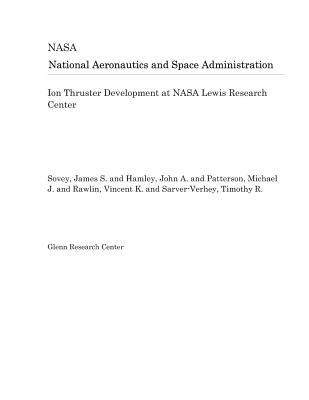Download Ion Thruster Development at NASA Lewis Research Center - National Aeronautics and Space Administration | PDF
Related searches:
Recent ion propulsion technology efforts at nasa's lewis research center including development of kw--class xenon ion thrusters, high power xenon and krypton ion thrusters, and power processors are reviewed. Thruster physical characteristics, perfornlance data, life projections, and power processor component technology are summarized.
Three ion thrusters – 13 cm, 25 cm and 30 cm – in the satellite market. The main product (l-3 eti) to embark on a program to develop a thruster to fill this need.
Fundamentals of electric propulsion: ion and hall thrusters march 2008 the research described in this publication was carried out at the jet propulsion laboratory, california institute of technology, under.
Working at nasa/lewis, harold kaufman invented an electron-bombardment technique to ionize mercury atoms. At nasa/marshall, they were developing a process where cesium atoms would become ionized upon contact with a hot tungsten or rhenium surface.
Deep space i validated the promise of ion thruster propulsion.
Journal of propulsion and power; journal of spacecraft and rockets; journal of thermophysics and heat transfer; browse all journals; browse all virtual collections.
With renewed interest in ion propulsion for orbital control of satellites and for propulsion of interplanetary spacecraft, nasa is investing in the future of ion propulsion. Both nasa’s evolutionary xenon thruster (next) and x3 – new systems under development—are more powerful than dawn’s thrusters.
18 dec 2019 deep space i validated the promise of ion thruster propulsion. Researchers at lewis research center (now nasa glenn) made significant technologies, including an ion propulsion system developed at nasa glenn.
Recent ion propulsion technology efforts at nasa’s lewis research center including development of kw‐class xenon ion thrusters, high power xenon and krypton ion thrusters, and power processors are reviewed. Thruster physical characteristics, performance data, life projections, and power processor component technology are summarized.
Nasa engineers built the first working ion thrusters at the nasa lewis research center (now glenn research center) in the early 1960s.
Development status of the nasa 30-cm ion thruster and power processor intersociety energy conversion engineering conference august 2012 performance characteristics of the deep space 1 flight spare ion thruster long duration test after 21,300 hours of operation.
The space electric rocket test i1 was launch- ed in february 1970 for the purpose of demon- strating long-life space operation of either one of two 15-cm diameter ion thrusters.
Nasa-tm-107037 nasa technical memorandum 107037 i_000 7q55 aiaa-95-2517 # development stares of the nstar ion propulsion system power processor johna.
Also added to the development of two new ion thrusters that use very high power. It has been an interesting time in the world of electric propulsion at nasa.
Over a 3 1/2-year development period, from 1966 to 1970, nasa's lewis research center undertook an effort to design, fabricate, and qualify a new ion thruster system and the supporting spacecraft components for the sert 2 (space electric rocket test) mission.
Ion thrusters (based on a nasa design) are now being used to keep over 100 geosynchronous earth orbit communication satellites in their desired locations, and three nstar ion thrusters that utilize glenn-developed technology are enabling the dawn spacecraft (launched in 2007) to travel deep into our solar system.
Programs and the internal programs at nasa lewis research center tc provide the necessary input to the engineering model thruster development. The responsibilities of this pyagram were divided into three distinct, but related tasks.
Ion thrusters, the propulsion of choice for science fiction writers have become the propulsion of choice for scientists and engineers at nasa. The ion propulsion system's efficient use of fuel and electrical power enable modern spacecraft to travel farther, faster and cheaper than any other propulsion technology currently available.
4 apr 2020 the ion thruster uses electricity, in powerful bursts similar to an arc welder, to produce plasma, and thrust.
A 30 cm diameter xenon ion thruster is under development at nasa to provide an ion propulsion option for auxiliary and primary propulsion on missions of national interest. Specific efforts include thruster design optimizations, component life testing and validation, vibration testing, and performance characterizations.
20 aug 2020 the typical development of research activity for electric propulsion systems, transitioning [51] and spt-140 [52], the near-term development of nasa's hall ucla, atonio piragino of sitael, rhodri lewis of qinet.
6 apr 1999 the purpose of nstar was to develop xenon ion engines for deep space missions.
5 to 2 kw' range are being developed at nasa's lewis research center (lerc) and also by hughes research laboratories (hrl) (refs. The nasa lerc device is 30 cm in diameter and is operated in a throttled or derated.
13 jan 2019 the x3 is made possible thanks to a collaboration among nasa, aerojet rocketdyne, the caltech jet propulsion laboratory, and the university.
Xenon ion propulsion systems are being developed by nasa lewis research center and the jet propulsion laboratory to provide flight qualification and validation for planetary and earth-orbital.
Recent ion propulsion technology efforts at nasa's lewis research center including development of kw-class xenon ion thrusters, high power xenon and krypton ion thrusters, and power processors are reviewed. Thruster physical characteristics, performance data, life projections, and power processor component technology are summarized.
27 mar 2021 pdf a 30 cm diameter xenon ion thruster is under development at nasa to provide an ion propulsion option for missions of national interest.
Kaufman in 1959 at the nasa glenn research center facilities. It was similar to a gridded electrostatic ion thruster and used mercury for propellant.

Post Your Comments: